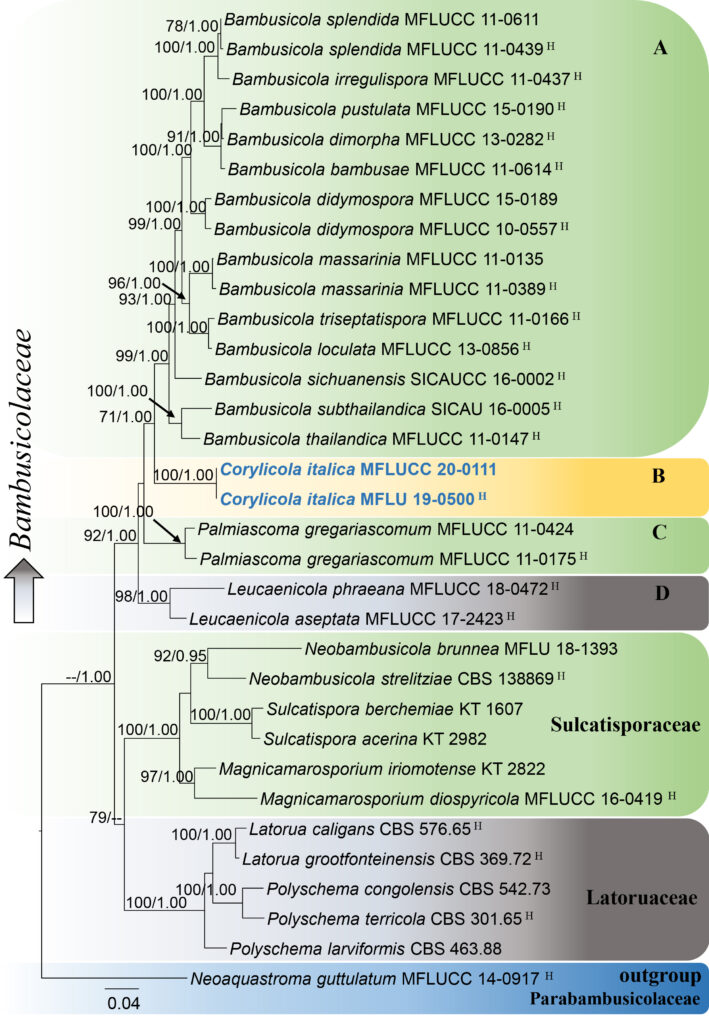Corylicola Wijesinghe, E. Camporesi, Yong Wang bis & K.D. Hyde, 2020, in Wijesinghe, Wang, Camporesi, Wanasinghe, Boonmee & Hyde, Biodiversity Data Journal 8(e55957): 7 (2020)
Index Fungorum number: IF557767; Facesoffungi Number: FoF 08684
Etymology: Referring to the host genus, Corylus
Description: Saprobic on dead branches of Corylus avellana L. Sexual morph: Ascomata solitary, scattered, immersed to erumpent, globose to subglobose, coriaceous, uni-loculate with an ostiole. Ostiole central, papillate, lined with hyaline periphyses. Peridium fused with host tissues, unequally thick, outermost layer comprising blackish to dark brown cells of textura angularis, inner layer comprising hyaline cells of textura prismatica. Hamathecium comprising numerous, dense, filamentous, cellular pseudoparaphyses with distinct septa. Asci 8-spored, bitunicate, fissitunicate, cylindrical, pedicellate, with an ocular chamber. Ascospores uniseriate, fusiform to ellipsoidal, yellowish to pale brown, single-septate, echinulate, accumulating as yellowish-brown masses at the apices of ascomatal neck. Asexual morph: Coelomycetous. Conidiomata pycnidial, solitary to gregarious, scattered, semi-immersed to superficial, globose to subglobose, uni-loculate to multi-loculate, ostiolate. Ostiolatecentral and circular. Conidiomata wall composed of several layers of pale to dark brown, pseudoparenchymatous cells. Conidiophores reduced to conidiogenous cells. Conidiogenous cells holoblastic, phialidic, ampulliform, yellowish to pale brown, aseptate, smooth-walled. Conidia solitary, globose or oblong to ellipsoid, rounded or obtuse ends, yellowish to pale brown, aseptate, rarely guttulate, smooth-walled.
Type species: Corylicola italica Wijesinghe, Camporesi, Yong Wang bis & K.D. Hyde, 2020, sp. nov.
Notes: – Corylicola gen. nov. is a monotypic genus associated with Corylus avellana L., which is commercially important for hazelnut production (Nitride et al. 2017). The new genus is characterised by didymosporous, brown and echinulate ascospores, which are morphologically similar to Palmiascoma (Bambusicolaceae), Didymosphaeria, Munkovalsaria and Verruculina (Didymosphaeriaceae) (Zhang et al. 2012, Liu et al. 2015). Phylogenetically, however, Corylicola forms a distinct lineage within Bambusicolaceae (Fig. 1 B). Corylicola differs morphologically from Bambusicola and Palmiascoma by the accumulation of ascospores as yellowish-brown masses at the apices of ascomatal necks. Bambusicola, Leucaenicola and Palmiascoma have coelomycetous asexual morphs, which are similar to Corylicola (Dai et al. 2012, Liu et al. 2015, Jayasiri et al. 2019). Asexually, Corylicola is characterised by holoblastic, phialidic conidiogenous cells similar to Palmiascoma and one-celled, aseptate conidia similar to Palmiascoma and Leucaenicola, whereas Bambusicola has 1–3-septate conidia (Hyde et al. 2013, Liu et al. 2015, Dai et al. 2017). Based on morphological observations, a key to all four genera of the family is provided.

Figure 1.
Phylogram generated from Maximum Likelihood analysis, based on combined SSU, LSU, ITS, RPB2 and TEF1 sequence data for Bambusicolaceae. Maximum Likelihood bootstrap values (ML) ≥ 70% and posterior probabilities (PP) ≥ 0.95 are given above each node. The GenBank accession numbers are provided at the right side of the species names. Strains of the novel species are visualised in blue-bold and holotype materials are symbolized with H.
Species
